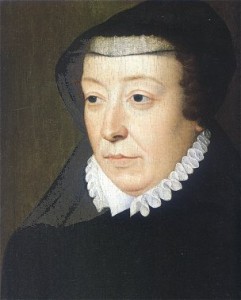Royal of the Month: Catherine de’ Medici
Catherine de’ Medici was born in Florence on April 13, 1519; her father was the Florentine Lorenzo II de’ Medici, Duke of Urbino and her French mother was Madeleine de La Tour d’Auvergne.
Tragically, her mother died ten days after giving birth to Catherine, whilst her father died on May 4, leaving Catherine a sole orphan and heiress to a great fortune. The infant Catherine was raised by her paternal grandmother, Alfonsina Orsini, and following her death, her paternal aunt, Clarice de’ Medici.

Catherine de’ Medici during her time as Queen of France
In 1523, her cousin, Pope Clement VIII, had Catherine moved to Florence and raised at the Murate Convent. In 1527, the Medici were briefly overthrown in Florence, Catherine was taken hostage and at one stage her life was in danger. With Medici rule re-established by 1530, Pope Clement had Catherine moved to Rome where he began marriage negotiations with both France and Scotland for her hand.
In early 1533, Pope Clement agreed to have Catherine marry Henri, Duc de Orléans, the second son of King Francis I of France. The marriage was celebrated at the Church of Saint-Ferréol les Augustins in Marseille in October 1533 infront of the entire French Royal Family and officiated by Pope Clement himself. Aside from the prestigious match, this marriage was also a political marriage between the Kingdom of France and the Papacy.
By 1536, Catherine was Dauphine of France following the death of Henri’s older brother, the Dauphin Francis. After many childless years, Catherine finally gave birth to a son – Francis – in January 1544. In total, Catherine gave birth to ten children, of whom seven survived infancy.
In March 1547, King Francis I died and Henri and Catherine became King and Queen of France; in June 1549, Catherine was crowned Queen at St Denis outside Paris. As Queen during this period, Catherine had very little influence as the King was preoccupied by his infamous mistress, Diane de Poitiers, who held real power. Catherine was more or less neglected and relegated to producing and raising the royal children, and they were soon joined by the young Mary, Queen of Scots who had been sent to France for her safety by her mother, Marie de Guise. This period of time also saw the rise of the Ducal House of Guise, headed by Charles, Cardinal of Lorraine and his brother, Francis, Duc de Guise; their sister Marie was the mother of Mary and Queen Regent of Scotland.
Despite being eclipsed by Diane de Poitiers at the French Court, Catherine formed two very strong friendships within the royal family: one with her husband’s aunt, Marguerite d’Angoulême, Queen of Navarre, and another with her husband’s younger sister, Marguerite de France, Duchess de Berry, both of whom were life-long friends.

The marriage of Henri II of France and Catherine de’ Medici
Catherine was appointed as Regent of France in 1552 and again in 1557 during her husband’s military campaigns. In April 1558, her eldest son, the Dauphin Francis, married Mary, Queen of Scots at Notre Dame de Paris. 1559 saw a further two diplomatic royal weddings: Catherine’s eldest daughter, Elisabeth, was married to Philip II of Spain, and her sister-in-law, Marguerite, was married to Emmanuel Philibert, Duke of Savoy. Both marriages were part of the Peace Treaty of Cateau-Cambrésis, by which France made peace with both the Holy Roman Empire and Spain. During one of the festivities to mark the double weddings, King Henri II was seriously wounded during a joust when a lance shattered in his face on June 30.
The King died on July 10, he was succeeded by his sickly fifteen year old son Francis, with Catherine as Regent of a bankrupt kingdom and with serious religious problems brewing between Catholics and Protestants. Following the death of Henri II, Catherine dressed only in the colour black as a widow, changing only for state occasions or weddings.
Catherine sought to relax her late husband’s policy of religious persecution, but this brought her into open conflict with the ultra-Catholic Guise family who held great power over the new King through their niece. One person whom Catherine took revenge on was Diane de Poitiers, who was forced to hand over all her royal jewels and was banished from the French Court.
In December 1560, Francis II died childless and was succeeded by his younger brother, Charles IX. Catherine summoned a meeting of the Estates General of France at Orléans where she was appointed Queen Regent with sweeping powers. The Queen Regent now set about trying to solve the bitter religious divides which were about to explode into violence across the kingdom.
The court was also divided – the Protestant faction was headed by Jeanne III d’Albret, Queen of Navarre, her husband, Antoine de Bourbon, and Admiral Gaspard de Coligny; while the Catholics were headed by the Duc de Guise and the Cardinals of Guise and Lorraine. Catherine did not trust either side and did not want either of them to hold power, so she sought a middle ground and a moderate policy for religious divide. However her moderate policies did not work, and the First War of Religion erupted in March 1562 in an orgy of violence.
The Huguenots appealed to Elizabeth I of England for aid, who sent them men and money in exchange for the port of Le Harve which Elizabeth seized and garrisoned with English troops. The Duc de Guise was assassinated in February 1563 and Catherine managed to end the First War by her Edict of Pacification, which was issued in March 1563. The Queen Regent also managed to unite both French Catholics and Protestant against the English at Le Harve which was retaken.
In 1564 Catherine and her son Charles IX, accompanied by the royal family and the entire government, began a three-year royal tour of the Kingdom of France in a bid to restore the prestige of the monarchy following the war. In 1567, war again erupted following an attempt by the Huguenots to seize the King and his mother at the Chateau de Meaux where they were residing.

A widowed Catherine de’ Medici
In 1570 Jeanne III of Navarre, accompanied by her son Henri and her daughter Catherine, arrived at the Huguenot stronghold of La Rochelle where she began to negotiate the Peace of Saint-Germain-en-Laye which was issued in August 1570 and ended the war. Catherine and Jeanne also began talks about a marriage between Henri and Catherine’s youngest daughter, Marguerite de Valois, which would cement a union between the Crown and the House of Bourbon.
After years of wrangling with Catherine, Jeanne III finally signed the marriage contract between Henri and Marguerite in 1572. The Queen of Navarre did not live long enough to see the wedding, dying in June 1572, she was succeeded by her son. The wedding of Henri and Marguerite was celebrated outside Notre-Dame de Paris on August 18, 1572. Thousands of Huguenots had arrived in the city for the wedding including most of their leadership.
On the night of August 22, royal troops began massacring all Huguenots in Paris, including their leader Admiral Gaspard de Coligny; Henri of Navarre survived by converting to Catholicism. Many historians have pointed the finger of blame for the brutal massacre of St. Bartholomew’s at Catherine de’ Medici and her image has been forever tarnished by this horrible episode in French history. Yet who ordered the massacre has been debated for many centuries – Charles IX, Catherine, the future Henri III of France and the ultra-Catholic Guise Family have all been suspects.
Charles IX died in May 1574, he was succeeded by his brother, Henri III, who was in Poland where he had been elected king the year before, so again Catherine was appointed Regent until the King returned to France. Soon after this, Henri of Navarre escaped from the French court and renounced Catholicism and took up the leadership of the Huguenot cause. In 1575, Henri III married Louise de Lorraine-Vaudémont, two days after his Coronation.
Civil War had erupted again and Catherine was crisscrossing the kingdom trying to bring the wars to and end. In 1579,despite her age and failing health she travelled to the south of France to meet with the Huguenot leaders and attempted to pacifying the south in the King’s name. The Catholics under the House of Guise had formed the Holy League against the Huguenots and had fallen out with Henri III.
By 1588, France was in chaos. Henri III had lost control of Paris to the Catholic League headed by the Duc and Cardinal of Guise and had fled, leaving his mother behind to negotiate. In December 1588, Henri III had the Duc and Cardinal of Guise murdered at the Chateau de Blois, by now the Queen Mother was old and mortally ill. Astute as ever, Catherine knew that no good would come from this double murder and on Christmas Day, she told her confessor, “Oh, wretched man! What has he done? Pray for him I see him rushing towards his ruin.”
A few days later, Catherine went to visit her cousin, the old Cardinal of Bourbon, who blamed her for all that had happened; broken by this rebuke the old Queen took to her bed where she died on January 5, 1589.
The death of Catherine left Henri III alone and isolated, he was assassinated in August 1589, only months after the death of his mother. As Paris was controlled by the Catholic League, Catherine’s funeral could not take place at Saint Denis; instead her remains were buried at the Collegial Church of Saint Sauveur de Blois. Here her remains lay until 1610 when they were reburied at St Denis beside her husband, Henri II.
Filed under France, Historical Royals, ItalyTagged Biography, Catherine de' Medici, House of Valois-Angoulême, Regency, Religion.









Leave a Reply